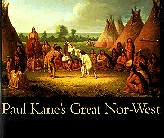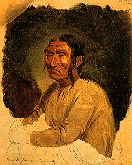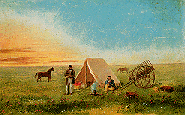

![]()

|
Paul Kane's Great Nor-West.
Diane Eaton and Sheila Urbanek. Subject Headings:
Grades 10 and up / Ages 15 and up.
****/4
|
excerpt:
On his return to Fort Vancouver two months later, Kane stopped at Cowlitz and went straight to the lodge of his old friend Kiscox. To his surprise, he found the chief and family that had once welcomed him so hospitably cool and peculiarly distant, the children even running away as he approached. After some time, Kiscox asked him if he had made a portrait of a woman on his last visit. `I said that I had,' Kane writes, `and mentioned her name, Caw-wacham . . . A dead silence ensued, nor could I get the slightest answer to my enquiries.' On leaving the lodge Kane met a mixed-blood Indian who told him that Caw-wacham had taken sick and died and that he, Kane, was believed to have caused her death. Fearing reprisal, Kane `immediately procured a canoe, and started for Fort Vancouver, down the river, paddling all night, well knowing the danger that would result from [his] meeting with any of her relations.'
Paul Kane (1810-1871) was a Toronto-born, and largely self-taught, artist who resolved early to make a lasting record of North American Indians and their traditional way of life. The central event of his career was a journey of two-and-half years through the wilderness, from the Great Lakes, through the Red River settlement (where he saw and painted one of the last great buffalo hunts), the Rockies, and into the Pacific Northwest.


Unfortunately, Kane's works, like the nineteenth-century world he strove to preserve in pictures and words, have faded from public attention. . . . his art and prose deserve more attention from a wider audience.
This book is essentially a rescue mission.
Highly recommended.
T.S. Causabon is a Winnipeg-based freelance writer.
To comment on this title or this review, send mail to cmeditor@mts.net.
![]()
Copyright © 1996 the Manitoba Library Association.
Reproduction for personal use is permitted only if this copyright notice
is maintained. Any other reproduction is prohibited without permission.
Published by
The Manitoba Library Association
ISSN 1201-9364
![]()